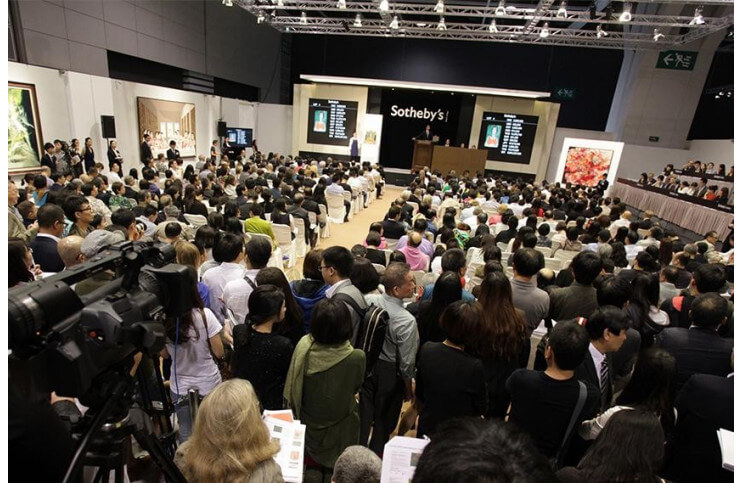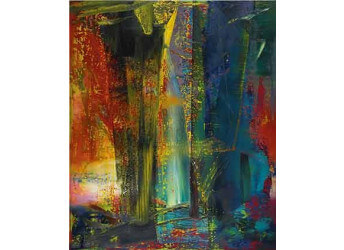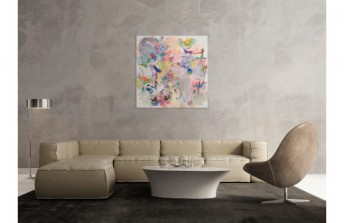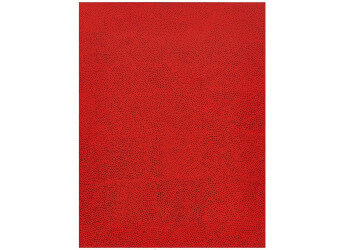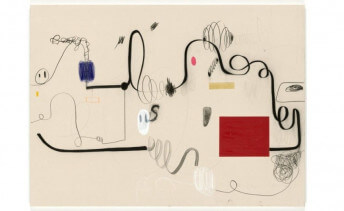There Are No Bubbles in Art
Mar 24, 2016
Although there has been a number of economic crashes (from the Great Depression back in 1929, throughout the Dot-com bubble in the 1990s, and onto the Housing bubble in 2008), the one that made a huge linguistic impact on everyday speech was the latest. Some might not believe it, but the term “bubble” was first used back in 1710s, and the idea was to describe the non-healthy inflation of stock prices (which could burst at any second just like a soap bubble). What one should note is that, according to expert opinions, economic crises/bubbles are regular manifestations of capitalism.
Art Market Bubble
As capitalism and its principles entered every area of human activity, there has recently been a speculation that the next bubble will be inflated in the art market. There is a reasonable doubt that the (possibly called) art-market bubble will not be a pleasant one, according to economists, journalists and biased folk. A question arises, could it be possible that this contemplation started on the exact date that the housing market crashed? On September 15, 2008, the Lehmann Brothers, the fourth-largest investment bank in the United States went bankrupt, which was a straightforward signal that the whole world will shudder soon. Meanwhile, across the Atlantic pond, Sotheby’s held a one-man auction of Damien Hirst’s works, provided straight from the hands of the artist, raising £111 million. A highly controversial artist was making millions from selling stuffed animals in formaldehyde, while middle class Americans where losing homes and all their savings. Could this be just a coincidence?
In the aftermath, different auction records of artwork sales (whether it is a contemporary artist’s work or Chinese antiques) have been documented. It stated that the art market had significantly developed in the last decade. While the prices were bursting, paintings were being resold for at least double their initial value gaining publicity through newspaper headlines.
Art market continued to record good results throughout 2010s, in spite of all the media attention and the persistence of the global economic crisis. However, the art market came to a breaking point in the middle of 2015, when the auction results started to tumble down – meaning that the rate of artwork prices exceeding its estimates went down and the buy-in rate (rate of works whose prices failed to reach a reserve price and therefore came back to the sellers) went up. The demand for prime oeuvres did not suffer a great blow, but artworks barely below this level confronted a more restricted bidding. In the fourth quarter of 2015, Sotheby’s experienced a loss in auction revenue, which statistically lead to a full year fail in analysts’ results prediction. There has been a growing belief that the art market is losing its reliability based on the expectations of the Sotheby’s revenue decrease by 33%.
Could this be a sign of the highly anticipated financial bubble emerging – the Art-market bubble – or is this just a normal development trend?
 Fabian Oefner - Iridient
Fabian Oefner - Iridient
Why People Think the Art Market Is a Bubble
Media usually has a significant influence on the creation of the economic expectations, especially those with a negative prefix. “The Great Contemporary Art Bubble” is a BBC documentary from 2009, composed out of one-sided opinions of dealers, artists and gallery owners, which predicted the inevitable crash of the art market. Despite it all, the art market realized a yearly growth of 13% (in average) during a period of 6 years, according to the Citi report 2015 based on the data compiled by Artnet.
According to the Citi report 2015, there has been no uniform price growth in the art market in 2000. Actually, the top 20% of the most expensive artworks grew faster than the rest (this is a so called fat tail distribution, undesirable because of the increased risk it showcases). This only implies that in the last 15 years, the presence of blue-chip art pieces has grown more in comparison to others. This is one of the reasons why media are keeping the art market in spotlight, creating the idea of speculative prices in people’s minds. The intensive growth of the gap between the world’s richest people (0,001% of the world’s population that can afford these works) and the poorer ones during the last years of the economic crises is actually causing the phenomenon.
Bloomberg’s anchor, Matt Miller, interviewed an analyst last week on the art market state and the last Sotheby’s performance results. Miller, who was unaware of who Willem de Kooning was, addressed how the art market is not considered a financial bubble if Ken Griffin could’ve bought his own building (worth half a billion dollars), rather than canvases by Pollock and de Kooning. This is a good way to point out how a less informed journalist of a well-known media source can form the general public opinion based on the refutable common-sense evidence. What also reinforces the opinion is the general public’s perception of art buying as a tax-evasion tool and the sale of highly expensive artworks by publicly barely known artists, such as Barnett Newman going for $ 80 million.
The existence of the Art-market bubble points out that all art valuations are overinflated, and thus wrong. This indicates that at some point artwork buyers will realize this and the demand for expensive artworks will start dropping until the market prices match the real prices. The problem lies in the fact that all art valuations are essentially abstract. While evaluating a company, bond or oil prices, there is a value of use (intrinsic value - although value is a highly controversial term even in economics), determined by the demand and supply forces on the market, which is not likely to exist in the example of a painted oil canvas. Artwork prices are determined based on a benchmark, which is usually a price of a similar piece of art previously sold, hence generating a self-supported price mechanism (meaning there is no solid ground for a pricing mechanism). Hence, this is considered to be the generator of financial bubbles. The thing is, prices where always being determined this way. Why should there be a problem now?
Bubbles basically come down to the inflation of prices which have no grounding in demand and supply forces. They have different origins and reasons such as excessive leveraging in financial products regarding mortgages (plus the wrong perception that the housing prices would always go up) during the Housing bubble in 2008; tech companies’ valuations based on the assumptions (wrong ones) of the number of page visits per day during the Dot-com bubble in the 1990s; But it is easy to see the problem retroactively and to be smart after the fact. Of course, it’s not a secret that there was a small group of business people (hedge funds) which got out of the Housing bubble with a lot of money (some of the details regarding this can be seen in the book that inspired the eponymous Oscar nominated movie “The Big Short”). Since then, people have been trying to make similar predictions (but if you look closer it began long before the Housing bubble, when the economics begun basing its scientific focus on the predictions and the game theory). This is not a simple task at all, close to being impossible (see Nassim Nicolas Taleb “The Black Swan”).
 Art Market
Art Market
The “Is There a Bubble on the Art Market?” Study
A University of Luxembourg economic study on the Art-market bubble, based on econometric models, was brought to public attention in 2015. The conclusion was that the bubble actually does exist, but above all, in the contemporary art market. As expected, this conclusion made its way to the major art media outlets, enforcing the bubble believers’ convictions as a consequence. But one should not rush to conclusions as fast. This is an econometric study that was based on regression models. The result of the regression, or should it be said – the end result – firmly depends on the data on which the model was constructed. Hence, if a mistake or difference of opinion was present in the data, the result can be bias. Not all data are suitable for certain types of regressions. They should not be taken lightly as well.
The thing that was perhaps kept under the table was that when dealing with art price-related studies, the data used to build a function depicting the price movement is always biased and insufficient. A pattern of the artwork trading cannot be made over time because there are not many repeats. Plus, the ones who stopped being traded because they lost value are just removed from the function (this is the so called survivorship bias). These models usually relay on the auctions data but most of the transactions (trading) are being made through dealers and galleries. All of this must be considered while discussing econometric studies which compare either art prices or art returns to other assets over time, or the potential existence of a financial bubble.
This study actually analyzes the data and tests it in a model believed to point out the possible existence of a bubble. All in all, the model shows that the bubble exists if the behavior of the intrinsic price (or the real price) of an asset does not match the behavior of the market price over the period of time. As one can suppose, the artwork does not have the intrinsic value (value of use) for comparison and the artworks market prices do not represent the complete reality, causing the existing problem. The model was built based on the auction houses, sales dates, media, work size, whether a work is signed and whether the artist is alive to determine the intrinsic value of an artwork. It can be assumed that these 6 variables alone are not valid enough to determine the value of an artwork. Thus, the results and the conclusions of the study must be analyzed with caution.
 Art Market Results
Art Market Results
So Why Are Auction Results Down in 2016?
While buying artworks such as paintings (although they are considered as consumer goods), people are not only thinking about it as an investment but as a possibility of gaining positive emotional returns. This different behavior is the reason why the comparison of art markets with other markets is so hard. People that buy art pieces, usually do it because they want to diminish their liquidity concerns (having extra money). So even if the bubble does burst, these collectors would not need to sell them as quickly as possible to gain money, causing a “herd effect” on the market (the way it was caused whenever there was a rumor about a bank going bankrupt causing waiting lines in front of ATM’s/bank counters of panic-stricken people wanting to withdraw their money).
There is always a possibility of the market being overvalued, but that does not mean that the financial bubble exists. The prices are changing and adjusting according to the market (conducted by demand and supply forces), and sometimes they can be lower or higher than the actual worth, until they reach the so called equilibrium price. This is the process that can be seen in the art market. But if there was a bubble, its bursting would bring all the prices down in a short period of time.
One of the explanations (besides the growth in the percentage of the world’s richest people) of the art market’s growth in sales, has been the entrance of Chinese players onto the market. As the Citi report stated, the previously outlined 33% of all revenue growth came from new Chinese collectors (supported by a government expansionary monetary policy). After the Chinese miracle was almost over the economy was not showing signs of growth as in the previous years, the market started to suffer. To illustrate this a bit better, we can compare this kind of a situation to a town where a big industry decides to set up a plant. With many employees arriving and having to find a place to live in, the housing prices grow as a consequence. If the factory continues to progress and expand, the prices would go even higher. However, when certain economic factors cause the company to stop hiring new staff (or even dismiss some of the existing ones), the apartment prices would stagnate or even decrease in value. This reaction is a correction, not a bubble. Nevertheless, if the new employees had decided to buy new apartments that were far more expensive than what they could indeed afford – artificially inflating the prices – for which they now do not have enough money to pay for, this is a bubble. Therefore, unless the Chinese buyers leveraged themselves to buy the artworks in question, there would not be a reason to believe that they have caused a bubble, or could potentially be able to burst it.
Other new collectors have also found the overall economic environment unfavorable to their cause. With the Oil prices at extreme low points, and no prediction of them rising any time soon, the EMEA and Russian collectors are hurt. Furthermore, the latter have seen their currency dramatically devaluated as well, and the Russian art market is showing evident signs of recession. The lower price levels that are visible in 2016 seem to be the contemporary trend, and with the US and European economies still struggling to their feet, the current situation seems to be very much unlike a bubble burst.
Featured Image: Sotheby’s 40th Anniversary Evening Sale (image used for illustrative purposes only)
